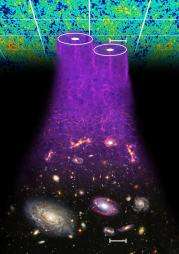Aussie galaxy survey to lead to 'new physics'

(PhysOrg.com) -- Australian astronomers have released the first set of data from the first project to look at the effects of "dark energy" halfway back in the Universe's lifetime.
Called WiggleZ (“wiggles”), the project is being done with the Anglo-Australian Telescope in NSW and is led by Professor Michael Drinkwater of UQ's School of Mathematics and Physics.
Dark Energy is an unidentified component of the Universe that is causing the expansion of the Universe to speed up.
Determining its nature is one of the key problems of physics today, and will lead to a "new understanding of physics," Professor Drinkwater said.
WiggleZ will get a handle on Dark Energy by measuring “wiggles” in the distribution of distant galaxies.
Because light takes time to travel through the Universe, looking far out is equivalent to looking back in time, and WiggleZ is observing galaxies that existed when the Universe was half its present age.
“By observing the size of the pattern at different times in the Universe's history, we can track the history of the expansion of the Universe, and thus determine the effects of Dark Energy,” Professor Warrick Couch of Swinburne University, a member of the WiggleZ team, said.
The “wiggles” pattern in galaxies in today's Universe was discovered in 2004 by two teams, one of which had used the Anglo-Australian Telescope for its galaxy survey.
WiggleZ will measure the redshifts (distances) of 240,000 galaxies, allowing astronomers to create a 3D map of galaxies stretching over a thousand square degrees on the sky and look for a pattern in the way they are clustered on large scales.
These galaxies are about halfway back in the Universe's history (4 to 8 billion years ago, corresponding to redshifts of between 0.2 and 1).
WiggleZ started in 2006 and, when finished in 2010, will be the largest galaxy redshift survey made to that time in terms of the volume of space it covers at such remote distances in the universe.
More than a dozen ground-based Dark Energy projects are proposed or under way, and at least four space-based missions, each of the order of a billion dollars, are at the design concept stage.
While the exact nature of Dark Energy is still unknown, there are only a few candidates.
A favoured one is the energy of empty space itself. But it could also be that Einstein's general theory of relativity, our current theory of gravity, is wrong on large scales.
Another approach to tracking the effects of Dark Energy is to look at the brightness of distant supernovae (exploding stars), and compare them with the brightness predicted for that time in the Universe's history. This is how Dark Energy was discovered in the first place.
However, there are uncertainties associated with the supernova approach related to how close in brightness all the supernovae are.
“The galaxy clustering method also has uncertainties, but completely independent ones, so the two methods provide a powerful cross-check to each other,” Dr Sarah Brough, a WiggleZ team member at the Anglo-Australian Observatory in Sydney, said.
The first WiggleZ data release, of 100,000 galaxies, is published in association with a paper in Monthly Notices of the Royal Astronomical Society.
More information: Michael J. Drinkwater et al. “The WiggleZ Dark Energy Survey: Survey Design and First Data Release.” Accepted for publication in the Monthly Notices of the Royal Astronomical Society. On astro-ph at xxx.lanl.gov/abs/0911.4246
Provided by University of Queensland (news : web)















